Key Points:
- Molting is the process of shedding fur, feathers, skin, or even the exoskeleton.
- There are many reasons for molting, including making more room to grow and changing coats for the new season.
- Some animals molt to attract a mate.
Did you know there are quite a few animals that molt? Molting is the process by which animals shed their skin, fur, feathers, or exoskeleton. There are many mammals, reptiles, insects, and even birds that molt for many reasons. Some of these creatures shed their exterior because they need room to grow, and others replace thick winter coats with more breathable summer attire. There are even animals that molt to better attract a mate — much like you might buy a new outfit for a first date!
The reasons for molting are almost as varied as the types of creatures that do so. In this article, we’ll learn about 10 interesting animals that molt.
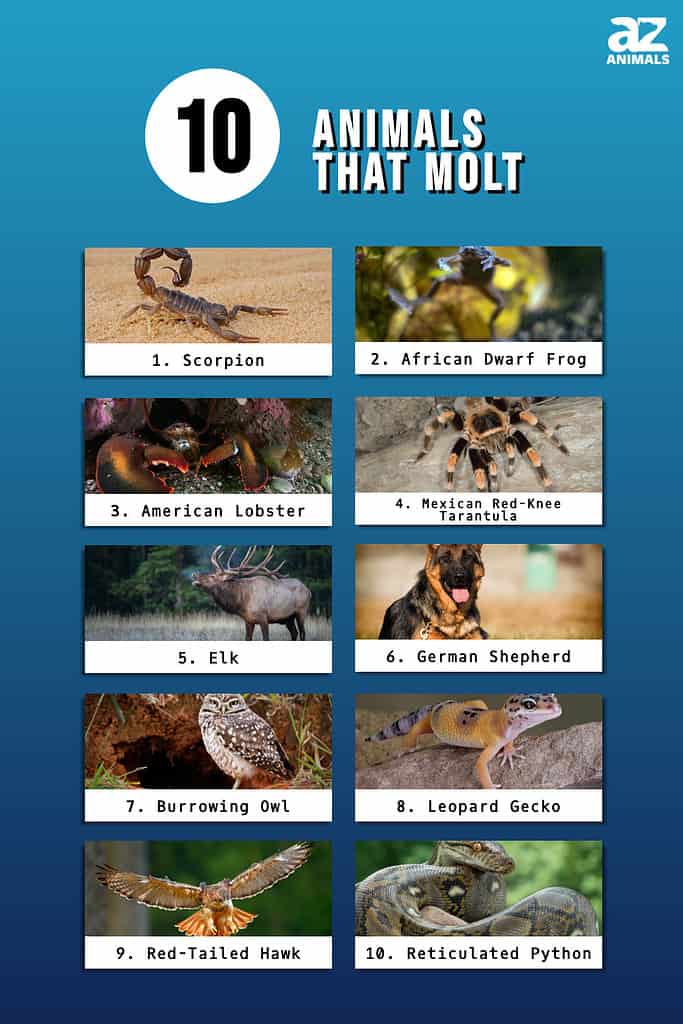
#10 Reticulated Python
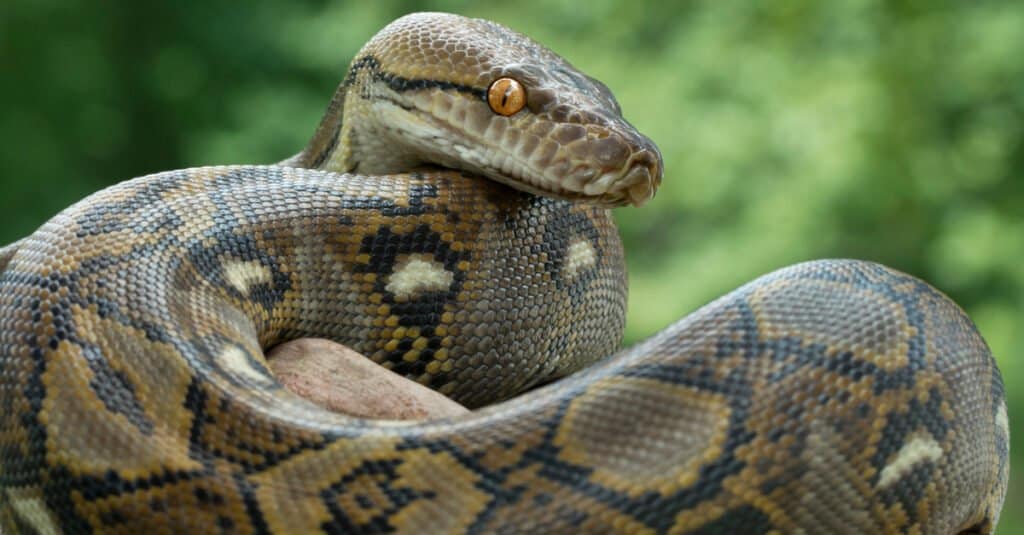
The reticulated python will molt its entire life, starting as soon as it’s hatched.
©Mark_Kostich/Shutterstock.com
Snakes are probably one of the animals that almost everyone is familiar with for molting or shedding their skin, but the reticulated python (Python reticulatus) is something special. This snake has no known maximum size and will continue to grow for as long as it lives. The longest recorded specimen was almost 30 feet long and weighed an astounding 550 pounds.
Reticulated pythons are native to Southeastern Asia, islands of the Indo-Pacific region, sections of Australia, and even tropical regions of Africa. They first molt as soon as they hatch, and they will continue to shed their skin to repair injury or facilitate growth their entire lives. When healthy, reticulated pythons will shed their entire skin in one piece like other snakes.
#9 Red-Tailed Hawk
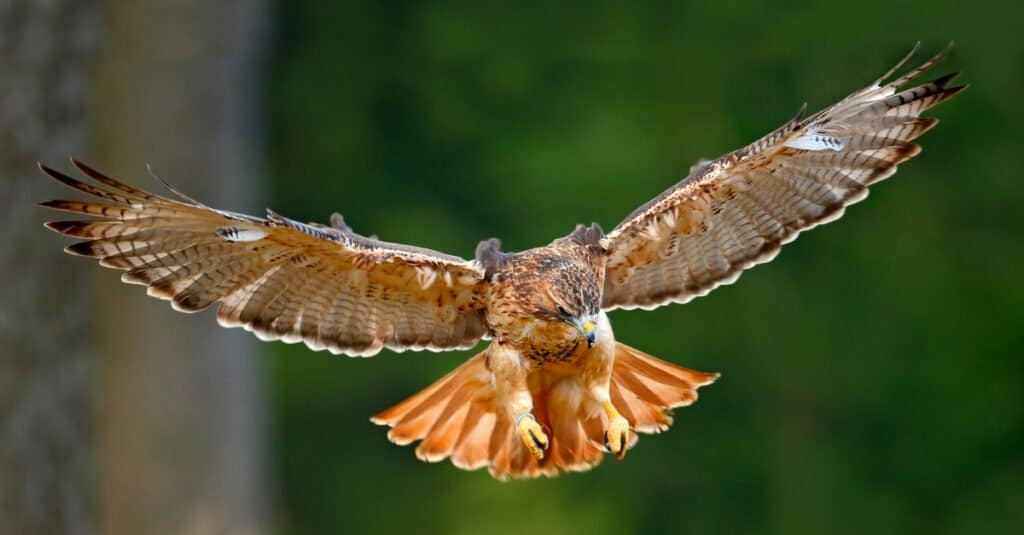
The red-tailed hawk’s distinct tail feathers are a result of the molting process.
©Ondrej Prosicky/Shutterstock.com
Birds are another common animal that is thought of when it comes to molting. The red-tailed hawk (Buteo jamaicensis) is found throughout North America and earned its name from the bright red tail feathers that it sports as a part of its adult plumage. That is a direct result of a molting process. Born with colors that are typically in the brown or white blotched with brown range, these hawks molt in the spring of their first year and gain adult flight feathers and red adult tail feathers. Going forward, they continue to molt around a breeding season which replenishes their distinct tail feathers, and it also replaces any feathers that have been lost or damaged over time.
#8 Leopard Gecko
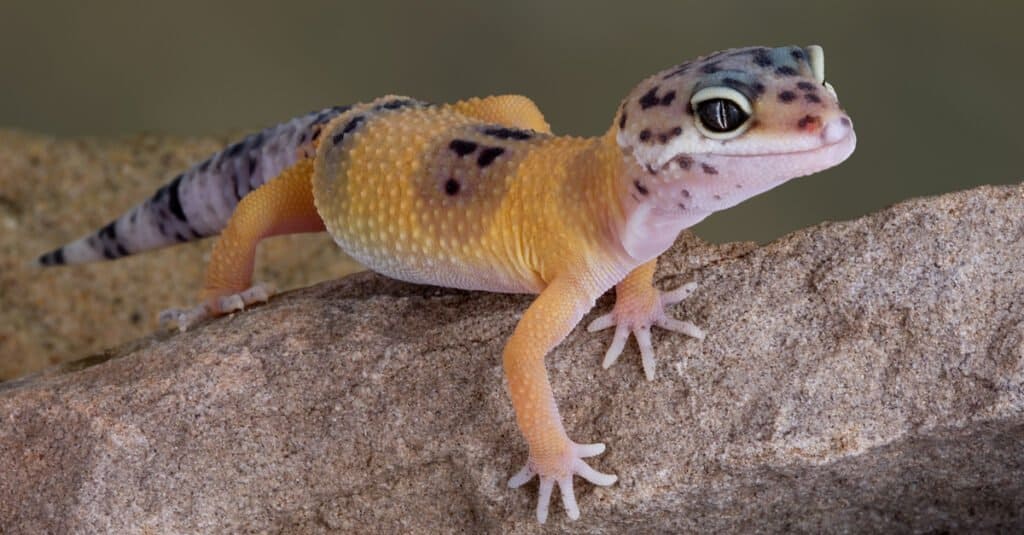
A regular pattern of molting isn’t common in adult geckos.
©Cathy Keifer/Shutterstock.com
The leopard gecko (Eublepharis macularius) is native to the Middle East, India, and Nepal, but it is most common as a popular household pet. These lizards are docile and easy to breed which has directly led to their popularity. They shed their skin because it does not expand as they grow much like other reptiles and lizards. Fast-growing, juvenile geckos can molt as often as once a week if they are having a growth spurt, whereas adult geckos do not follow a regular pattern of molting.
An interesting fact about the leopard gecko is that it consumes its shed skin during the molting process. It’s not known exactly why they do so, but it is suspected that the geckos either require the additional nutrients or eat them to conceal their presence from possible predators.
#7 Burrowing Owl
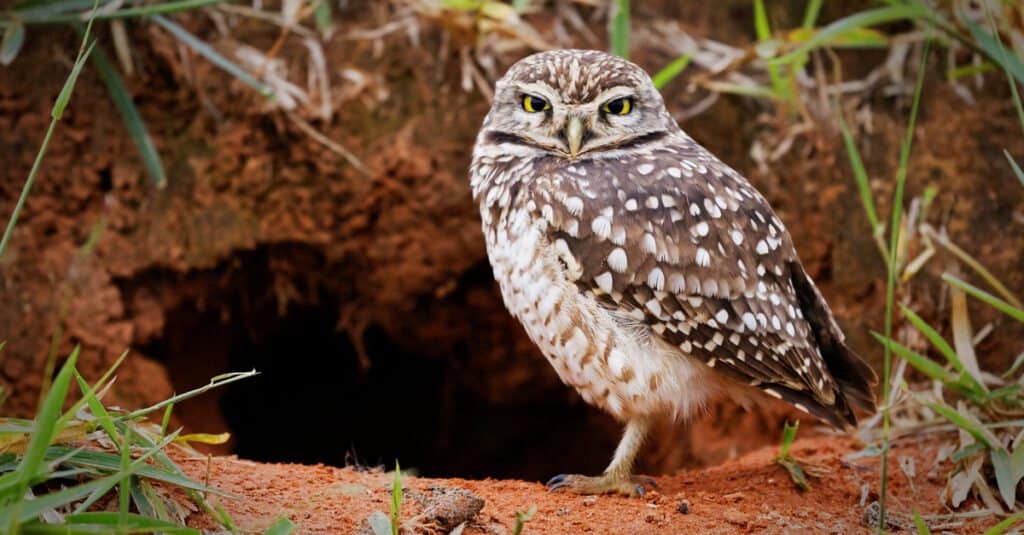
The end of the breeding season leads to a
burrowing owl
‘s annual molt.
©Mauricio S Ferreira/Shutterstock.com
Burrowing owl (Athene cunicularia) are widespread in both North and South America and molt like almost all birds. What is interesting about the burrowing owl is that they are ground-dwelling owls that feed primarily on small mammals. They have been studied across various parts of their range, and researchers learned that wild, migratory burrowing owls synchronize their annual molt with the end of the breeding season. Presumably, this is done to optimize the replacement of feathers that had been damaged by long periods of time in their grounded nests.
Their molting periods can be as short as several weeks but can also extend to multiple months depending on a variety of factors. What is consistent across all of these birds is that they will fully replace all of their feathers before their molt is complete.
#6 German Shepherd

The German shepherd has a much thicker coat in the winter than it does in the spring.
©Happy monkey/Shutterstock.com
Domestic dogs (Canis lupus familiaris) also molt. This act is much more noticeable in breeds such as the German shepherd which is accustomed to living in colder climates. Pronounced periods of shedding fur occur normally in the spring and autumn. The spring molt tends to be much more obvious as the dog loses the heavy winter coat that is used to insulate itself from the elements. Shedding in the autumn is less pronounced in many dog breeds as the summer coat is thinner; however, long-haired breeds like the German shepherd manage to throw off an impressive amount of hair.
The first several shedding cycles of a new puppy’s life have also been known to alter the dog’s coloring slightly.
#5 Elk

The elk licks its body to speed up the molting process.
©Ghost Bear/Shutterstock.com
Much like the domestic dogs above, wild animals like the elk (Cervus elaphus) also molt twice yearly. Also like dogs, the spring molt is much more obvious to the eye as the long, winter coat is completely shed and new hair regrows all over the elk’s body, but the fall molt occurs with the winter coat growing in over the much shorter summer coat. Elk don’t shed all of this fur without some measure of annoyance. It is an extremely common sight to see these animals scratching or licking all parts of their body that they can reach to accelerate the loss of this fur.
#4 Mexican Red-Knee Tarantula
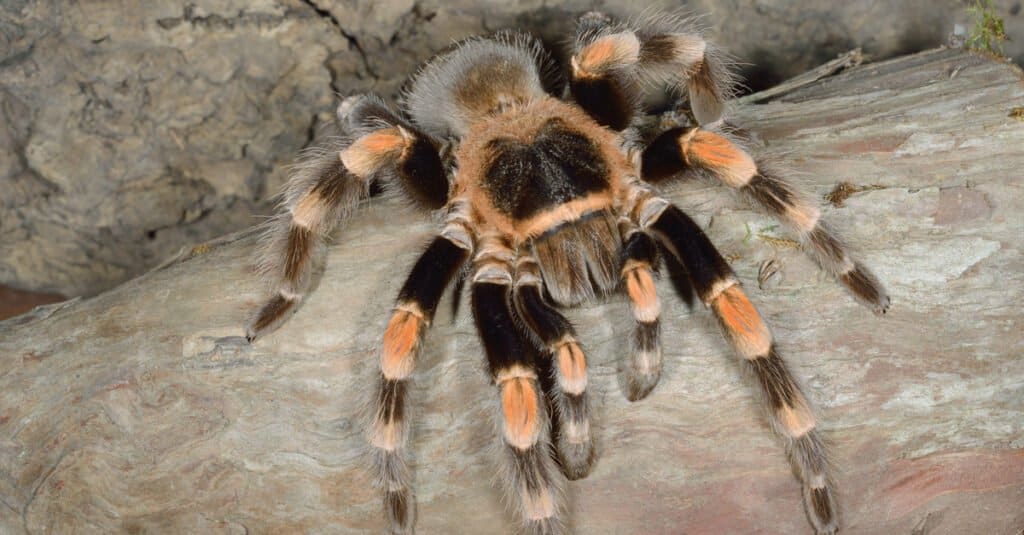
The male Mexican red-knee spider does not molt after five years old.
©Dean Pennala/Shutterstock.com
Arachnids are yet another group of animals that molt, and like many of the other creatures on this list, they need to do so to grow. Spiders like the Mexican red-knee tarantula (Brachypelma smithi) are encased in a hard external structure called an exoskeleton. The exoskeleton gives the spider the structure and support that an internal skeleton gives to mammals, but the exoskeleton is incapable of growing with the animal-like our bones do.
As the name suggests, Mexican red-knee tarantulas are found in Mexico, but they are also frequently purchased as pets. Their striking appearance with banded legs and red knees is quite the sight, and they are docile enough to handle. Newly hatched spiderlings will molt every two weeks for up to four months and then not as frequently afterward. Males do not molt after approximately five years old, but females do continue to shed their exoskeleton albeit infrequently.
#3 American Lobster
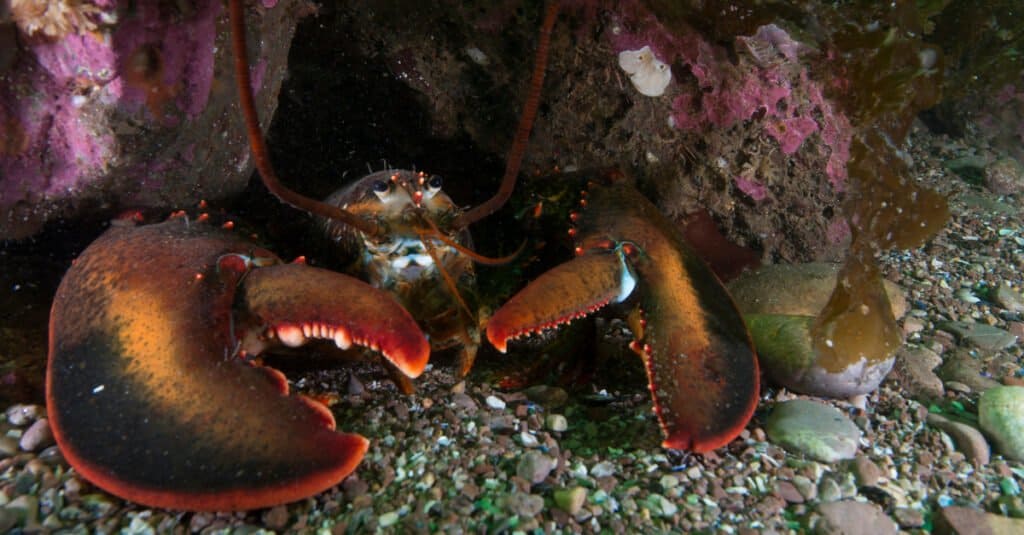
For the American lobster, the molting process can result in death.
©RLS Photo/Shutterstock.com
The American lobster (Homarus Americanus) which is also known as the Maine or Atlantic lobster is yet another animal that molts, and it is the largest species of lobster in the world. Not only do these lobsters molt, but the cause of most lobsters’ natural deaths is actually rooted in the cessation of molting. Lobsters are another creature that will continue to grow throughout their lives, and as they also reside within an exoskeleton, they need to shed their shell to keep growing. Lobsters have reached estimated ages above 100 years; however, they eventually stop producing the chemical that allows their molting process to begin. Once that occurs, lobsters become prone to a host of bacterial and other infections of the shell that eventually become fatal.
The largest American lobster ever recorded weighed in at just under 45 pounds and was believed to be around 100 years old. These crustaceans also possess the ability to regenerate damaged, infected, or lost claws and legs.
#2 African Dwarf Frog
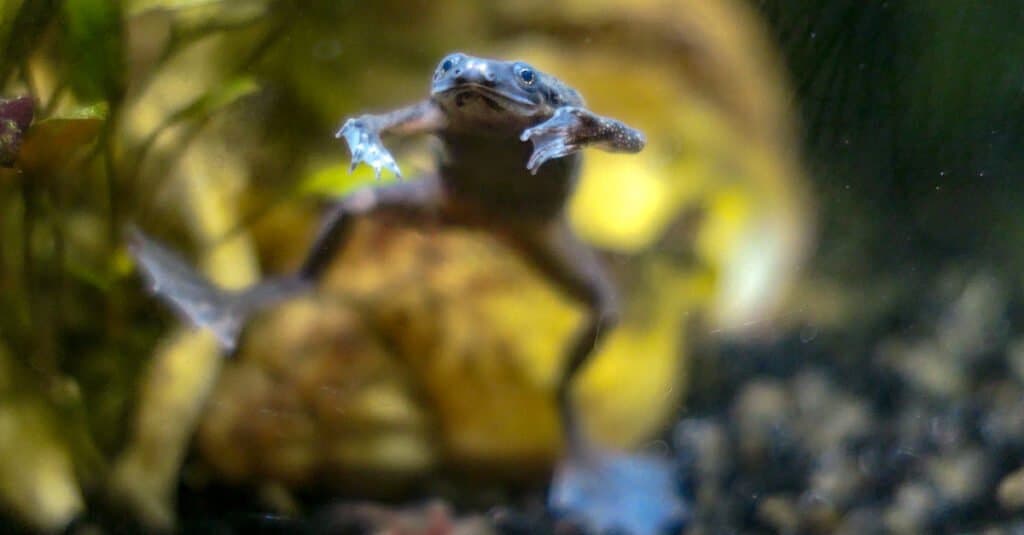
The African dwarf frog can shed its skin in one whole piece.
©Charlie Tyack/Shutterstock.com
Amphibians in general mostly shed their skin, and frogs like the African dwarf frog (Hymenochirus boettgeri) are no different. Since these frogs actually breathe through their skin, molting allows them to maintain a moist, breathable barrier that is free from fungus, disease, and any potential parasites. A cloudy appearance of their skin is a sign of an oncoming molt, and the skin is normally shed in either one whole piece or several large pieces. Shedding in multiple small patches can be a sign of an infection.
African dwarf frogs are similar to the leopard gecko in that they also frequently consume their skin after molting to replace nutrients lost in the process. Frogs vary in that some will eat during their one- to three-day long molting session while others will fast.
#1 Scorpion

Molting is a sign that the scorpion is independent of its mother.
©EcoPrint/Shutterstock.com
Our final animal that molts bears a close resemblance to a land-based lobster but is actually more closely related to spiders. Scorpions are arachnids that are found throughout the world, and they range in size from under 0.5 inches up to 7 inches long. Baby scorpions ride on the back of their mother after birth, and they become entirely independent immediately following their first molt. At that point, they leave their mother and venture off into the world where they prefer warm, dry locations. These nocturnal hunters hide during the day and do the majority of their moving about at night.
As you can see, there are so many animals in the world that molt. From those with fur or scales to skin-breathing amphibians and our feathered friends, their reasons for molting are almost as varied as the types of animals themselves, and we didn’t even mention any of the animals that undergo a metamorphosis along with their molting.
Summary of the 10 Animals That Molt
Here is a recap of the 10 creatures we looked at that shed their exterior.
| Rank | Animal | Reason for Molting |
|---|---|---|
| 1 | Scorpion | Growth |
| 2 | African Dwarf Frog | Maintain a moist, breathable skin barrier |
| 3 | American Lobster | Growth |
| 4 | Mexican Red-Knee Tarantula | Growth |
| 5 | Elk | Seasonal |
| 6 | German Shepherd | Seasonal |
| 7 | Burrowing Owl | Replace damaged feathers |
| 8 | Leopard Gecko | Growth |
| 9 | Red-Tailed Hawk | Replace damaged feathers |
| 10 | Reticulated Python | Repair injury or facilitate growth |
The photo featured at the top of this post is © Albert Beukhof/Shutterstock.com
Thank you for reading! Have some feedback for us? Contact the AZ Animals editorial team.






